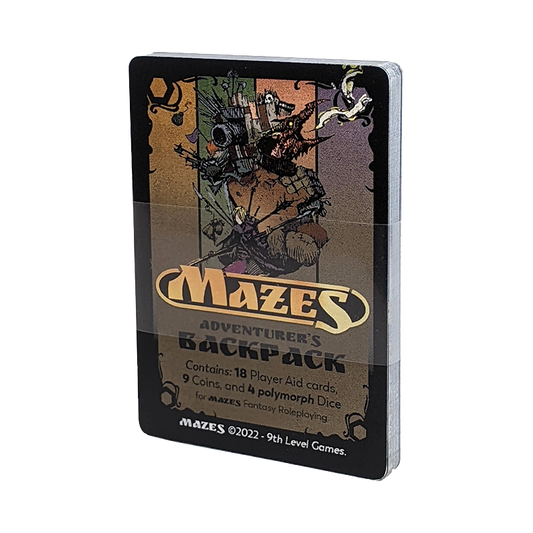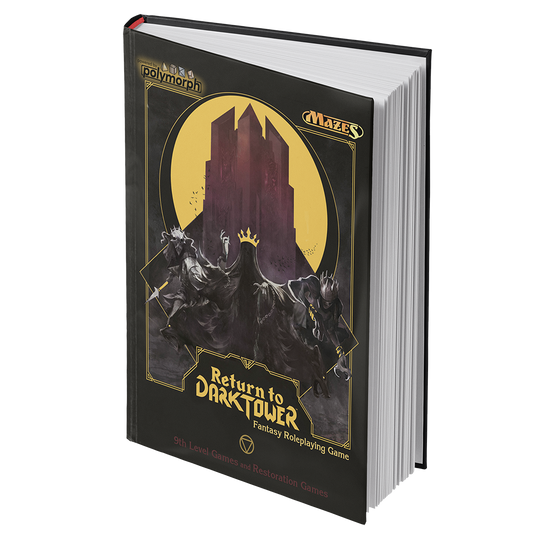 As described in Part 1 of this Thunder Road: Vendetta Roleplaying Game Design Diary, we had a team, we had ideas… now we just needed a game.
As described in Part 1 of this Thunder Road: Vendetta Roleplaying Game Design Diary, we had a team, we had ideas… now we just needed a game.
The first step was starting with some polymorph™ system basics. Since Thunder Road: Vendetta is an action game, starting with Mazes/Return to Dark Tower was a good starting point. The basic breakdown of the different actions on the Resolver generally mapped pretty well. Additionally we needed a set that both fit the feel of Thunder Road: Vendetta and would work well for both in and out of your vehicle. We got some basic actions that were pretty easy, and initially went for car parts:
- Gears (for how things work)
- Arsenal (for guns and other weapons)
- Wheels (maneuverability, agility, and more)
- Body (toughness and ramming)
Later in the process, Chris would pitch the alliterative, more catchy set that also evoked the board game more:
- Shift
- Shoot
- Steer
- Slam
That left the two special resolutions, which in Mazes are the Crown and Key. In order to hammer the themes of Thunder Road: Vendetta and add a resource-scarcity element, I added Fuel as a resource, and made that what you spend if you really want to succeed. That became the Pedal, which you put to the metal when you really need to get something done.
It took me longer than I’d like to admit to realize that Key still works as-is, since, well, cars have keys. This was another genre element we needed to make sure we added: in some RPGs, you’re encouraged to be tactical and cautious, and doing wild, unexpected maneuvers often comes with extra risk. This is often framed as being more “realistic.” Thunder Road: Vendetta is not that game. To really fit the world established by the board game, setting your motorcycle on fire before jumping off a ramp is a way to improve your odds, not reduce them. And so this was how we put the Keys in the ignition: if you’ve described your action appropriately epic enough, that can turn a failure into a success. It also carries with it the idea of grabbing the Keys makes you the center of attention… for good and bad.
One of the other goals was to let those who like to add flourishes to their actions be rewarded, while also not requiring everyone to be “On” all the time for descriptions. Fortunately polymorph is already built for this: the d4s and d6s are the more dynamic roles that benefit the most from action-packed descriptions, while the d8s and d10s are more reliable and can function just fine if you mainly just want to say “I shoot that guy” without being more descriptive.
We had our basics, we had some resources, we did some playtesting, and felt like we had a solid chassis to work with. By this point, we also had a pretty good idea of what parts of the setting we wanted to cover in the book. We had a well of personalities from the board game to draw from (especially the Chop Shop expansion), plus a few questions raised by the setup of the board game we had a chance to address.
There were two big mechanical pieces that we wanted to make sure we covered in the book that didn’t really exist in Mazes: how to run driving set piece scenes, and how to run your very own post-apocalyptic settlement.
Clark started off building a sample way to run chases, inspired by both how the board game plays and his experience with dogfighting in his excellent RPG Tachyon Squadron. That would end up getting some adjustments as the system developed and as playtesting occurred, and then expanded out into other types, like races, escapes, and skirmishes. These optional setups help give guidance to MCs on how to run exciting car combat scenarios in their games.
Settlement building is part campaign structure and part overarching goals. I’ve always enjoyed building my own towns and such in RPGs and video games, and fits in with how you and the other players form your own crew and how you get by in the wasteland. It also gives you ideas for missions: are you low on fuel? On raw materials? Do you just want to conquer a settlement and take their stuff because they have things that you don’t have? All that is supported.
This isn’t everything that the book covers, especially on the setting side. The goal was to build on the polymorph system while keeping it fast, and dare I say, furious when introducing cars in the mix. From those basics we took a toolbox approach, without getting into a lot of the nitty-gritty of how cars work, because that’s not really what the setting is about. It’s about driving, shooting, ramming, wrecking, and we can’t wait for you to experience it.
Last chance to back! Pledge your support for Thunder Road: Vendetta RPG before it's too late.





